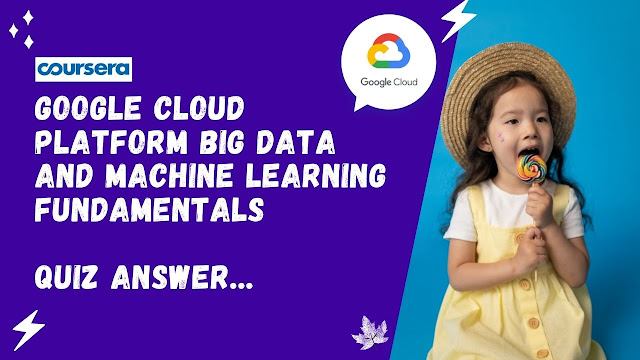Google Cloud Platform Big Data and Machine Learning Fundamentals
All Quiz Answer
Module Review Quiz 1
Q1) What are the common big data challenges that you will be building solutions for in this course? (check all that apply)
- Migrating existing on-premise workloads to the cloud
- Analyzing large datasets at scale
- Building streaming data pipelines
- Applying machine learning to your datasets
Q2) You have a large enterprise that will likely have many teams using their own Google Cloud Platform projects and resources. What should you be sure to have to help manage and administer these resources? (check all that apply)
- A defined Organization
- Folders for teams and/or products
- A defined access control policy with Cloud IAM
Q3) Which of the following is NOT one of the advantages of Google Cloud security
- Google Cloud will automatically manage and curate your content and access policies to be safe for the public
Q4) If you don't have a large dataset of your own but still want to practice writing queries and building pipelines on Google Cloud Platform, what should you do ?
- Practice with the datasets in the Google Cloud Public Datasets program
- Find other public datasets online and upload them into BigQuery
- Work to create your own dataset and then upload it into BigQuery for analysis
Q5) As you saw in the demo, Compute Engine nodes on GCP are:
- Allocated on demand, and you pay for the time that they are up.
Module Review Quiz 2
Q1) Complete the following:
You should feed your machine learning model your _______ and not your _______. It will learn those for itself!
- data, rules
- False
Q3) True or False: If you are migrating your Hadoop workload to the cloud, you must first rewrite all your Spark jobs to be compliant with the cloud.
- False
- Use PVMs or Preemptible Virtual Machines
- Migrate your storage from on-cluster HDFS to off-cluster Google Cloud Storage (GCS)
- Consider having multiple Cloud Dataproc instances for each priority workload and then turning them down when not in use
- May be imported from a bucket into a Hadoop cluster for analysis
- May be required to be read at some later time (i.e. load a CSV file into BigQuery)
- Transactional updates on relatively small datasets
- Running it on Google infrastructure offers reliability and cost savings
- Fully-managed versions of the software offer no-ops
Module Review Quiz 3
- Query service
- Storage service
# Run the below query:
SELECTCOUNT(*) AS total_tripsFROM`bigquery-public-data.san_francisco_bikeshare.bikeshare_trips`
- In the BigQuery Web UI, find the table and click the details tab and view the rows.
Q3) True or False: You can query a Google Spreadsheet directly from BigQuery without loading it in first.
- True
ride_id
ride_timestamp
ride_status
You want to use BigQuery for reporting but you don't want to split your table into multiple sub-tables. What native features of BigQuery data types should you explore? (check all that apply)
- Consider adding lat / long geographic data points as new columns and using GIS Functions to quickly plot the distances your fleet has travelled.
- Consider making ride_timestamp an ARRAY of timestamp values so each ride_id row in your table could still be unique and easy to report off of.
In ML, a row of data is called a(n) ________ and a column of data is called a(n) _______. We mark one or more columns as ________ which we know for historical data and are trying to predict for future data.
instance or observationfeaturelabels
Module Review Quiz 4
- Transactional updates on relatively small datasets
Q2) Cloud SQL and Cloud Dataproc offer familiar tools (MySQL and Hadoop/Pig/Hive/Spark). What is the value-add provided by Google Cloud Platform?
- Fully-managed versions of the software offer no-ops
- Running it on Google infrastructure offers reliability and cost savings
- Try the Cloud Vision API first






0 Comments